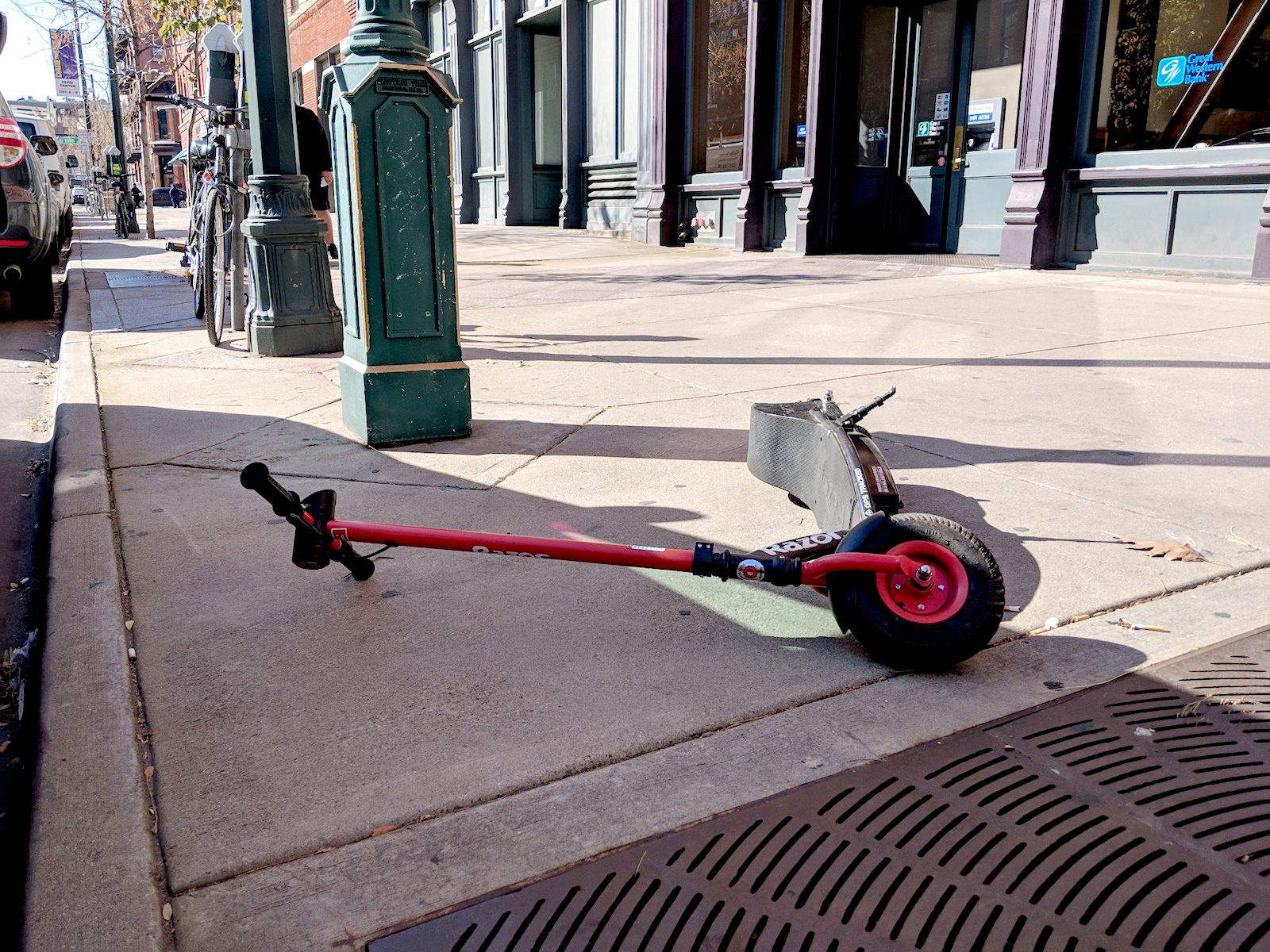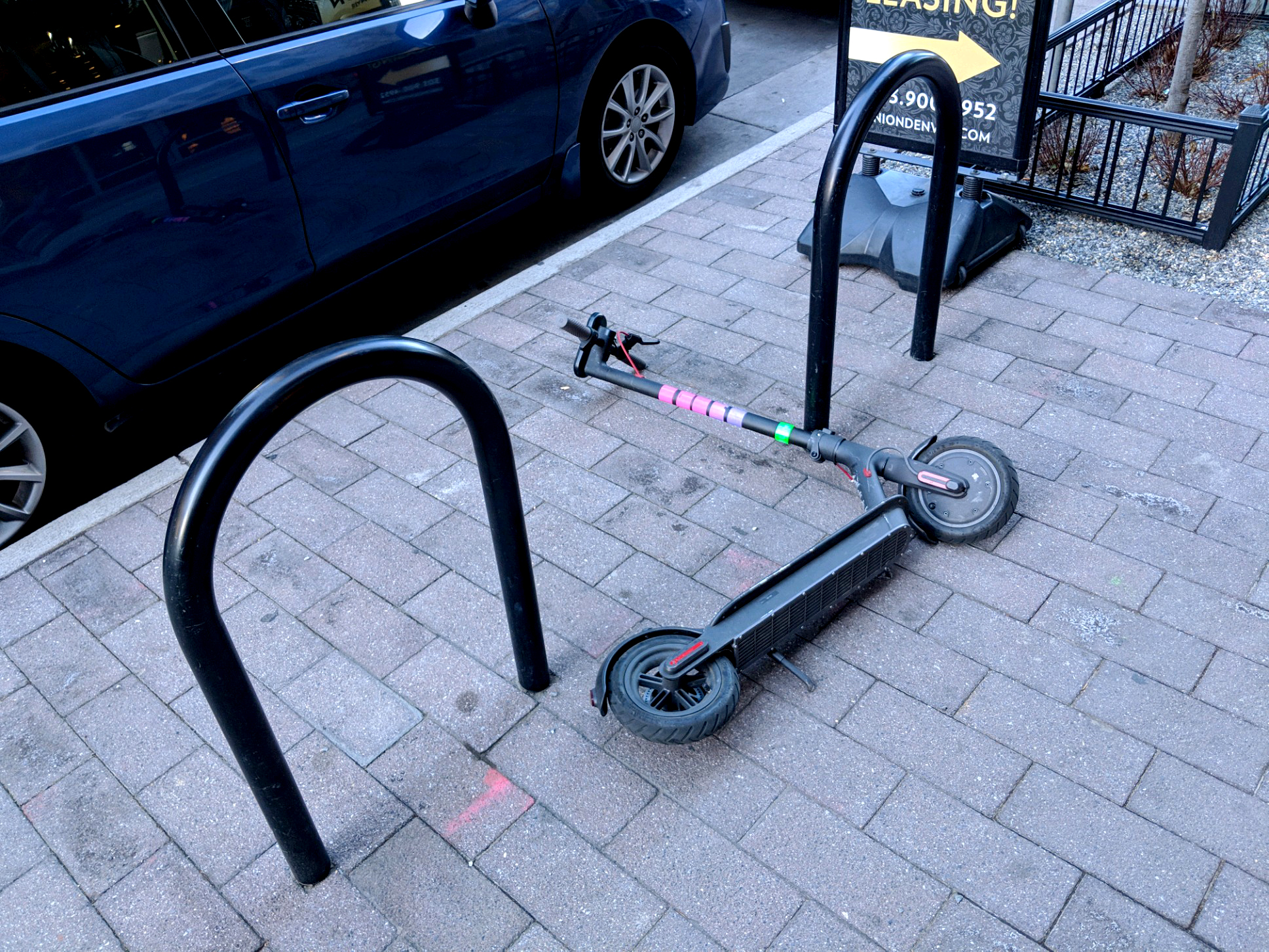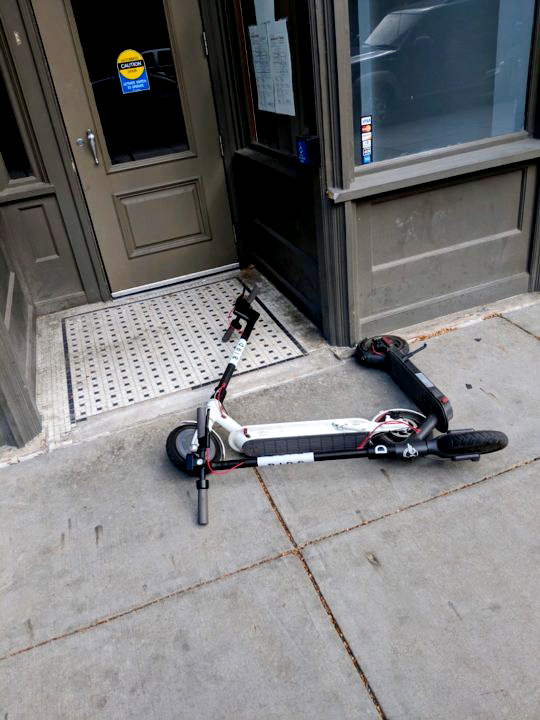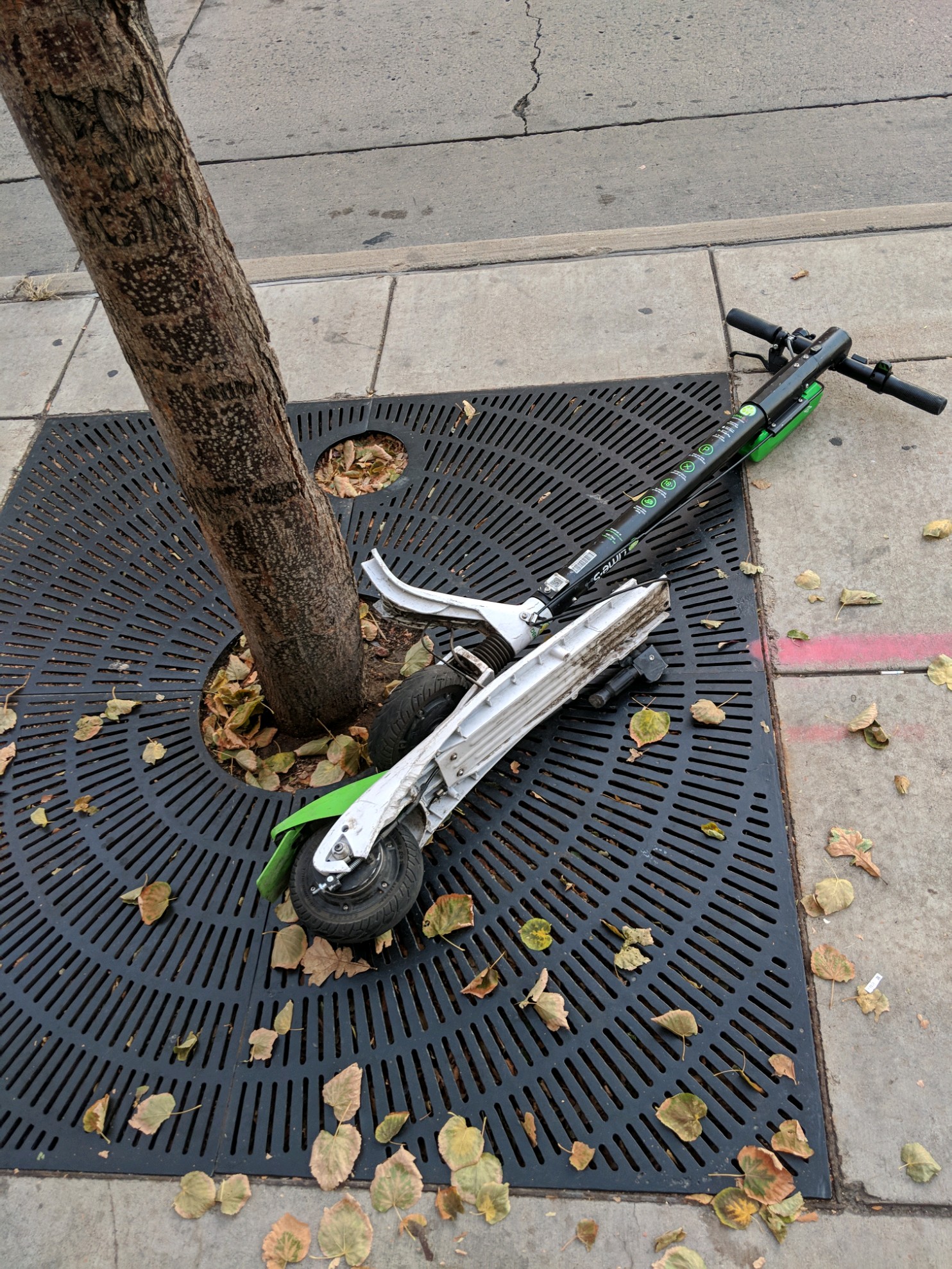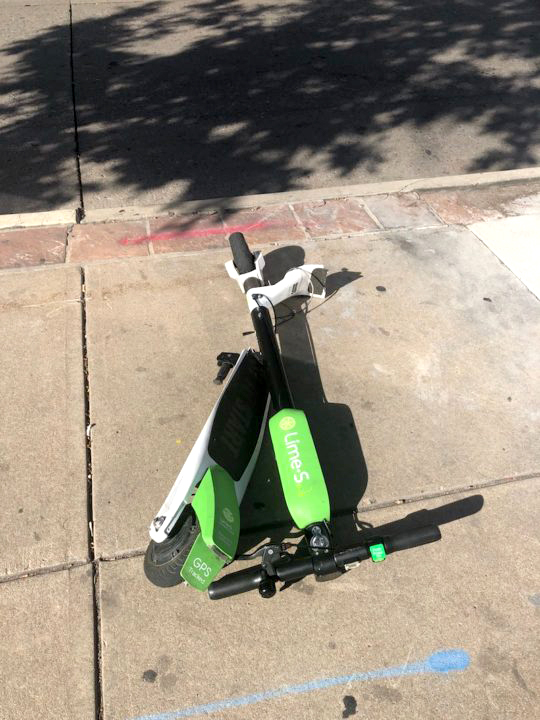The Local newsletter is your free, daily guide to life in Colorado. For locals, by locals.
When electric scooters suddenly infiltrated Denver’s streets this past summer, I was skeptical, but curious and eager to learn more. Working for 5280 offered me an opportunity to explore the new transportation method through reporting. Scooters became my beat. I wrote about scooters when Bird and Lime arrived essentially unannounced in May and subsequently got booted from the city. I wrote about scooters when they came back in July under stricter regulations, and when Lyft and Razor joined the party this fall.
For the past six months, I’ve covered Denver’s transformation into a scooter city, while carefully withholding my prejudices. I wanted to see how the scooters would integrate into the city, and I even became cautiously optimistic that Denver’s pilot program would be effective. But as summer gave way to fall, scooters of every brand were left toppled on sidewalks. They were discarded on our bike trails. They were found snapped in half and abandoned. At least one was even tossed off a bridge into the Platte River. Because the 5280 office is in LoDo, the epicenter of scooter activity, I’ve probably had more exposure than the typical Denver resident. But from what I’ve seen, the hippest two-wheelers in town are looking less like an innovative solution to our transportation woes, and more like urban litter unworthy of the Mile High City.

Sure, the scooters themselves are a nuisance, but the unrealistic and unenforcible rules set by the city have left the companies with an uphill climb. City guidelines mandate that the scooters be parked upright and adjacent to existing bike racks at RTD bus stops so they don’t impede pedestrian flow. But cruise around downtown, and you’ll find many scooters have been parked randomly on sidewalks, posing a risk to pedestrians and creating accessibility concerns for those in wheelchairs or pushing strollers.
What’s more is that Denver ordinance classifies scooters as “toy vehicles” that must be ridden on the sidewalk and, unlike most other cities, are prohibited from operating in roadways or in bike lanes. So, local pedestrians must avoid riders cruising down city sidewalks at 15 miles-an-hour, something that “doesn’t really make sense for anybody,” says James Waddell, executive director of BikeDenver. “The fact that they can only be on the sidewalk is pretty limiting and quite dangerous.” The city is considering updating the “toy vehicle” ordinance (spring 2019 is the target date for proposed changes), but for now the scooters must remain on the sidewalk.
When I was reporting this summer, I asked city officials about these issues, and was told “these things take time” and that with every new form of transportation there are “learning curves.” Fair enough. I waited to see if the scooters would become less disruptive. But as more arrived—Spin was the last company to launch here, bringing the total number to 1,750—the more I’ve become convinced Denver residents and visitors are unwilling to treat the new technology, and the city itself, with respect.
I recently reached out to Lime and Bird—the two longest-operating e-scooter companies in Denver—about some of the challenges facing scooters in the city and sent along several photos of discarded scooters taken by 5280 staff. Bird did not respond to a request for comment. A Lime spokesperson wrote in an email that less than one percent of the company’s 35,000 scooters nationwide have been vandalized and that each scooter is “equipped with built-in sensors that can track when a scooter or bike has fallen down or if someone is trying to steal it.” The spokesperson wrote that Lime is testing a system in which users take a picture of the scooter at the end of each ride to ensure that it is parked correctly. Lime also recently announced that it is pledging $3 million to a campaign called “Respect the Ride,” which encourages more responsible riding, including addressing improperly parked scooters.
Hey @BirdRide, @bmizz505 and I found one of your scooters in the Platte River pic.twitter.com/wIRMrVlghC
— Anders D Lund (@AndersDLund) August 13, 2018
When I approached the city this week for comment, a spokesperson wrote that Denver Public Works “continues to monitor behavior and is in close communication with the operators about any compliance issues.” The extent to which the city is holding the operators accountable is still unclear, but the Dockless Mobility Pilot Permit Program runs through next summer and the permits are revokable. The city spokesperson noted that it’s “too early to determine at this time if the [pilot program] will be extended” next July.
Now, I understand there are many advocates who want rentable scooters to work in Denver and in cities across the country. And for good reason. The scooter companies claim they’re taking cars off the streets and reducing emissions. Earlier this summer, a Lime spokesperson told me that over a one-week period, 7,000 Denver residents and visitors made more than 16,000 trips on their scooters, covering 22,000 miles and saving 20,000 pounds of would-be CO2 emissions. If accurate, that’s an encouraging metric. But I can’t help but wonder to what extent that benefit is offset by scooters left abandoned around the city and then retrieved by company representatives via vehicles—an impact which is surely harder to measure.
The cycling community (to which my daily commute to and from work makes me an active member) is largely receptive of the dockless scooters’ growth, as well. In July, BikeDenver and Bicycle Colorado issued a joint statement, arguing “these technologies can play a pivotal role in achieving the goals laid out in Denver’s Mobility Action Plan,” which aims to increase the number of people utilizing alternative transportation modes and reduce greenhouse gas emissions by 80 percent by 2050.
The cycling community is an active and powerful coalition, both locally and nationally, and the fact that cyclists support e-scooters is worth our attention. For instance, when I spoke with Waddell, he told me he had just hopped off an electric scooter. “[Cyclists] generally believe scooters are a good thing,” he said. “It’s giving people a chance to move around the city in some way other than a vehicle, which is what we’re trying to change behavior around.”
It also can’t hurt that scooter companies have pledged to help fund bike lanes in cities where they operate. Maybe the cycling community is embracing scooters because it recognizes a common ally in the ongoing discussion to expand infrastructure, but most of the cyclists I’ve spoken with seem patient and at least mildly supportive (if not downright enthusiastic) about the influx of scooters. Outside magazine even sent its “Bike Snob” to Portland to write a review of the e-scooters, which he called “laughably benign.” He concluded the piece by writing: “Really, if this is the future, what’s not to like?”
No offense to the Bike Snob, who lives in New York City where there are not yet e-scooters, but there’s a big difference between visiting a scooter city and living in one. In September, an older gentleman stopped by the 5280 offices to express his concerns about the “electric scooters possessing our sidewalks.” This man lives at a downtown senior living facility, and said that he and his fellow residents are genuinely scared that they’ll be hit by one of the many scooters zooming outside of their front door. In fact, I’ve spoken with dozens of people who recall nearly being bowled down by distracted riders.
As a pedestrian, the safety concerns are obvious. But I didn’t understand why the devices were being abandoned so haphazardly until I tried one myself. If operating without full charge, the tiny machines risk losing their scoot before you ever reach your destination—which was the case on the warm Sunday afternoon in late August when my roommate and I tried scooting from Coors Field to our house near Sloan’s Lake. We downloaded the apps for Lime and Bird, and set off looking for their respective scooters. Our search proved difficult. We kept arriving at pick-up locations only to find scooters swooped by other riders. When we did find unattended scooters and scanned their codes, they were often dead or broken. Finally, after 30 or so frustrating minutes, we found two scooters near REI and sped away—me on a black-and-white Bird and my roommate on a green Lime.
We crossed I-25 on 23rd Avenue and rode up the steep hill—my scooter struggling a bit—and then crossed Federal. As my roommate cruised ahead on his sporty Lime, my fatigued Bird lost its charge. It flew no more. Still a ways from home, I tried kicking my scooter forward, but the Bird only chirped: “Hey, idiot, your scooter’s dead. Go no further. Big Brother’s watching” or words to that effect. Frustrated, I leaned the scooter against a random tree on the sidewalk and waited for my roommate to realize I was not in tow. He eventually circled back and I stepped on to the back of his scooter—a decision I will forever regret. For the record, my roommate is 6-foot-6, and when he’s standing on a scooter he naturally attracts attention. The addition of me saddling up behind him and clinging to his hips increased the onlookers tenfold (or at least it felt like it). I have since repaired my esteem but have not risked climbing on another scooter since that day.
Even though I’ve sworn off electric scooters, I understand there are plenty of Denverites who think they’re downright groovy. In fact, when we polled our Instagram followers about the scooters a few months ago, 59 percent responded that they “Love ’em” while just 41 percent indicated they “Hate ’em.” Just because they’re not for me doesn’t mean scooters should be banned. But the city must address some of the inherent issues if the scooters are going to stick around for the long term.
With the pilot program expiring next summer, Denver officials ought to do something to address the proliferation of discarded scooters—perhaps by more forcefully requiring the companies to hold individuals accountable and by creating permanent designated parking areas. The city should also consider reducing the number of rentable scooters. Unless Denverites prove that they can follow established regulations and better respect the city, having nearly 2,000 scooters available for rent is simply too many.
Moreover, the scooters cannot remain on our sidewalks. The city needs to update its ordinance to allow scooters to operate in bike lanes and on bike paths throughout the city. While taking scooters off the sidewalks poses its own risk of injury, it is a better alternative than putting unknowing pedestrians in harm’s way.
In a perfect world, Denver might have proven the new technology is the future of urban transportation. Unfortunately, residents and visitors are failing the social experiment—opting for the convenience, but neglecting the accompanying responsibility. It isn’t crazy to want to walk down the sidewalks without fear of injury, or to not want to look at broken toy vehicles strewn about town. I’m not calling for the eradication of scooters, but if Denver is going to be a scooter city, we need to go about it in a different (and more thoughtful) way.




